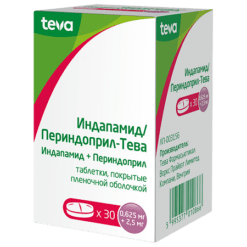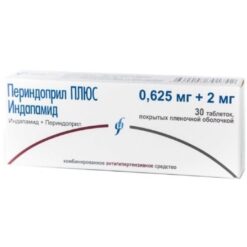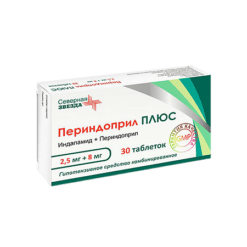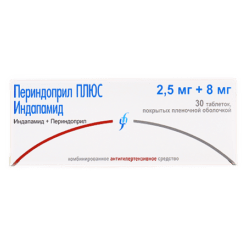No products in the cart.
Perindopril PLUS Indapamide, 1.25mg+4 mg 30 pcs
€16.08 €13.40
Description
Pharmgroup:
Antihypertensive drug.
Pharmacological action:
Combined product containing perindopril (ACE inhibitor) and indapamide (diuretic of sulfonamide group). The pharmacological effect of the drug is due to the combination of the individual properties of each of the components, the combination of which enhances the effect of each other. The drug has antihypertensive, diuretic, vasodilator and cardioprotective effects.
Perindopril PLUS Indapamide has dose-dependent significant hypotensive effect on systolic and diastolic BP in prone position and while standing irrespective of the patient’s age and body position. The action of the drug lasts for 24 hours. Stable clinical effect occurs in less than 1 month from the beginning of therapy and is not accompanied by tachycardia. Discontinuation of therapy is not accompanied by development of withdrawal syndrome.
Perindopril PLUS Indapamide decreases the degree of left ventricular hypertrophy, improves arterial elasticity, decreases PPS, has no effect on lipid metabolism (total cholesterol, HDL, LDL, triglyceride) and does not affect carbohydrate metabolism (including in diabetic patients).
Perindopril belongs to the group of ACE inhibitors and has hypotensive, vasodilator, cardioprotective, natriuretic effects. It inactivates ACE in plasma, endothelium of the vascular wall, possibly in the cells of renal glomeruli and tubules, lung, heart, adrenal and brain tissue. Reduces angiotensin II levels in blood and tissues, decreases production and release of aldosterone from adrenal glands, inhibits release of noradrenaline from sympathetic nerve fiber endings and endothelin formation in vascular wall, increases concentration of bradykinin, vasodilator prostaglandins. Increases the activity of kallikrein-kinin system, stabilizes the level of atrial natriuretic peptide.
The decrease of angiotensin II formation is accompanied by an increase of blood plasma renin activity.
Reduces PPS, BP (without development of tachycardia), left ventricular filling pressure. Arterial and venous vasodilation is accompanied by weakening of post- and preload on the myocardium, reduction of end diastolic pressure in the ventricles of the heart, a moderate decrease in heart rate, increase in cardiac output. It improves regional (coronary, cerebral, renal, muscular) blood flow, reduces myocardial oxygen demand in CHD.
Inhibiting tissue renin-angiotensin systems, it has cardioprotective effect (reduces left ventricular hypertrophy) and angioprotective effect (prevents hyperplasia and proliferation of vascular smooth muscle cells, induces reverse development of vascular wall hypertrophy, restores elasticity of large vessels and endothelial function, including the ability to release oxytocin.including the ability to release nitric oxide, endothelial relaxing factor).
Inhibits the development of tolerance to nitrates and increases their vasodilating effect.
In patients with chronic heart failure it statistically reliably decreases the severity of clinical symptoms and increases exercise tolerance. It does not cause BP fluctuations after the first dose and during long-term therapy.
Indapamide by its pharmacological properties is close to thiazide diuretics (it disrupts sodium ions reabsorption in cortical segment of the Genle loop); it has hypotensive, diuretic and vasodilator effects. It increases urinary excretion of sodium and chlorine ions and, to a lesser extent, potassium and magnesium ions. It has the ability to selectively block slow calcium channels, increases elasticity of arterial walls and decreases ARPS. Helps reduce left ventricular hypertrophy. It reduces the sensitivity of the vascular wall to noradrenaline and angiotensin II, stimulates the synthesis of prostaglandin PgE2 and prostacyclin PgI2, reduces the production of free and stable oxygen radicals.
The hypotensive effect of indapamide is manifested in doses with little or no diuretic effect.
Pharmacokinetics:
The pharmacokinetic parameters of perindopril and indapamide are unchanged when combined compared to their separate use.
1. Perindopril
When administered orally, perindopril is rapidly absorbed from the GI tract. Bioavailability is 65-95%, decreasing by 35% with concomitant food intake. Cmax is reached after 1 hour and decreases to 33-44% by the end of the day.
During metabolism perindopril is biotransformed to form the active metabolite perindoprilat (about 20%) and five inactive compounds. Cmax of perindoprilat is reached after 3-4 hours.
The binding to plasma proteins is insignificant, less than 30% and depends on the drug concentration. Vd of free perindoprilat is 0.2 l/kg.
Repeated administration of perindopril does not result in its cumulation and the T1/2 of perindoprilat when repeatedly administered corresponds to its period of activity. Css on repeat administration is reached in 4 days.
Perindoprilat is excreted by the kidneys. The T1/2 of the free fraction of the metabolite is 3-5 h. Slowly dissociates from binding to ACE, therefore the T1/2 corresponding to the activity of the drug is 25-30 hours.
Pharmacokinetics in special clinical cases:
In elderly patients as well as in patients with renal and cardiac insufficiency, excretion of perindopril is delayed (dosing regimen correction is necessary). Dialysis clearance of perindopril is 70 ml/min.
In patients with cirrhosis hepatic clearance of perindopril is decreased by half, while the total amount of perindoprilate produced does not change and dosing regimen adjustment is not required.
2. indapamide
Indapamide is rapidly and completely absorbed from the gastrointestinal tract after oral administration; bioavailability is high. Food intake slows down a little the speed of absorption, but does not affect the total amount of absorbed drug. TCmax in blood plasma is 1-2 hours after oral administration. Fluctuations in plasma concentrations between 2 doses are reduced with repeated administration. Css is established after 7 days of regular administration.
The binding to plasma proteins is 71-79%. Indapamide also binds to the elastin of the smooth muscles of the vascular wall. It has a high Vd. Permits through histohematic barriers (including placental). It does not cumulate.
It is metabolized in the liver. T1/2 is 14-24 hours (on the average 19 hours). The kidneys excrete 60-70% as metabolites (about 5-7% unchanged), the intestines excrete 20-23%.
Pharmacokinetics in special clinical cases:
In patients with renal insufficiency pharmacokinetics of indapamide does not change.
Indications
Indications
– arterial hypertension.
Pharmacological effect
Pharmacological effect
Pharmaceutical group:
Antihypertensive drug.
Pharmaceutical action:
A combination drug containing perindopril (ACE inhibitor) and indapamide (a sulfonamide diuretic). The pharmacological effect of the drug is due to the combination of the individual properties of each of the components, the combination of which enhances the effect of each other. The drug has antihypertensive, diuretic, vasodilating, cardioprotective effects.
Perindopril PLUS Indapamide has a pronounced dose-dependent hypotensive effect on systolic and diastolic blood pressure in the supine and standing position, independent of the age and body position of the patient. The effect of the drug lasts 24 hours. A persistent clinical effect occurs in less than 1 month from the start of therapy and is not accompanied by tachycardia. Discontinuation of treatment is not accompanied by the development of withdrawal syndrome.
Perindopril PLUS Indapamide reduces the degree of left ventricular hypertrophy, improves arterial elasticity, reduces peripheral vascular resistance, does not affect the metabolism of lipids (total cholesterol, HDL, LDL, triglycerides) and does not affect the metabolism of carbohydrates (including in patients with diabetes).
Perindopril belongs to the group of ACE inhibitors and has hypotensive, vasodilatory, cardioprotective, and natriuretic effects. Inactivates ACE in plasma, endothelium of the vascular wall, possibly in the cells of the renal glomeruli and tubules, lung tissue, heart, adrenal glands and brain. Reduces the level of angiotensin II in the blood and tissues, reduces the production and release of aldosterone from the adrenal glands, suppresses the release of norepinephrine from the endings of sympathetic nerve fibers and the formation of endothelin in the vascular wall, increases the concentration of bradykinin and vasodilatory prostaglandins. Increases the activity of the kallikrein-kinin system, stabilizes the level of atrial natriuretic peptide.
A decrease in the formation of angiotensin II is accompanied by an increase in plasma renin activity.
Reduces peripheral vascular resistance, blood pressure (without the development of tachycardia), left ventricular filling pressure. Arterial and venous vasodilation is accompanied by a weakening of post- and preload on the myocardium, a decrease in end-diastolic pressure in the ventricles of the heart, a moderate decrease in heart rate, and an increase in cardiac output. Improves regional (coronary, cerebral, renal, muscular) blood circulation, reduces myocardial oxygen demand in coronary artery disease.
By inhibiting tissue renin-angiotensin systems, it has a cardioprotective effect (reduces left ventricular hypertrophy) and angioprotective effect (prevents hyperplasia and proliferation of vascular smooth muscle cells, induces the reverse development of vascular wall hypertrophy, restores the elasticity of large vessels and endothelial function, including the ability to release nitric oxide, endothelial relaxing factor).
Inhibits the development of tolerance to nitrates and enhances their vasodilating effect.
In patients with chronic heart failure, it statistically significantly reduces the severity of clinical symptoms and increases exercise tolerance. Does not cause fluctuations in blood pressure after the first dose and during long-term therapy.
Indapamide is similar in pharmacological properties to thiazide diuretics (impairs the reabsorption of sodium ions in the cortical segment of the loop of Henle); has a hypotensive, diuretic, vasodilator effect. Increases the excretion in urine of sodium, chlorine ions and, to a lesser extent, potassium and magnesium ions. Having the ability to selectively block slow calcium channels, it increases the elasticity of arterial walls and reduces peripheral vascular resistance. Helps reduce hypertrophy of the left ventricle of the heart. Reduces the sensitivity of the vascular wall to norepinephrine and angiotensin II, stimulates the synthesis of prostaglandin PgE2 and prostacyclin PgI2, reduces the production of free and stable oxygen radicals.
The hypotensive effect of indapamide manifests itself in doses that practically do not cause a diuretic effect.
Pharmacokinetics:
The pharmacokinetic parameters of perindopril and indapamide when combined do not change compared to their separate use.
1. Perindopril
When taken orally, perindopril is rapidly absorbed from the gastrointestinal tract. Bioavailability is 65-95%, decreased by 35% with simultaneous food intake. Cmax is reached after 1 hour and decreases by the end of the day to 33-44%.
During metabolism, perindopril is biotransformed to form the active metabolite perindoprilate (about 20%) and 5 inactive compounds. Cmax of perindoprilat is achieved after 3-4 hours.
Plasma protein binding is insignificant, less than 30% and depends on the concentration of the drug. Vd of free perindoprilate – 0.2 l/kg.
Repeated administration of perindopril does not lead to its accumulation and T1/2 of perindoprilat upon repeated administration corresponds to the period of its activity. Css with repeated application is achieved after 4 days.
Perindoprilat is excreted by the kidneys. T1/2 of the free metabolite fraction is 3-5 hours. It slowly dissociates from connection with ACE, as a result of which T1/2 corresponding to the activity of the drug is 25-30 hours.
Pharmacokinetics in special clinical situations:
In elderly patients, as well as in patients with renal and heart failure, the elimination of perindopril slows down (correction of the dosage regimen is necessary). Dialysis clearance of perindopril is 70 ml/min.
In patients with liver cirrhosis, the hepatic clearance of perindopril is reduced by 2 times, while the total amount of perindoprilate formed does not change and no adjustment of the dosage regimen is required.
2. Indapamide
After oral administration, indapamide is quickly and completely absorbed from the gastrointestinal tract; bioavailability is high. Eating slightly slows down the rate of absorption, but does not affect the final amount of the drug absorbed. TCmax in blood plasma – 1-2 hours after oral administration. With repeated doses, fluctuations in plasma concentrations of the drug in the interval between 2 doses decrease. Css is established after 7 days of regular use.
Plasma protein binding – 71-79%. Indapamide also binds to the smooth muscle elastin of the vascular wall. Has a high Vd. Penetrates through histohematic barriers (including placental). Does not cumulate.
Metabolized in the liver. T1/2 – 14-24 hours (average 19 hours). 60-70% is excreted by the kidneys in the form of metabolites (about 5-7% is excreted unchanged) and 20-23% is excreted through the intestines.
Pharmacokinetics in special clinical cases:
In patients with renal failure, the pharmacokinetics of indapamide do not change.
Special instructions
Special instructions
Perindopril PLUS Indapamide:
Treatment is carried out under the supervision of a doctor.
The use of Perindopril PLUS Indapamide can cause a sharp decrease in blood pressure, especially when first taking the drug and during the first 2 weeks of therapy. The risk of developing an excessive decrease in blood pressure is increased in patients with reduced blood volume (as a result of following a strict salt-free diet, hemodialysis, vomiting and diarrhea), with severe heart failure (both in the presence of concomitant renal failure and in its absence), with initially low blood pressure, with bilateral renal artery stenosis or stenosis of the artery of a single kidney, cirrhosis of the liver, accompanied by edema and ascites. A pronounced decrease in blood pressure when taking the drug for the first time is not an obstacle to its further use. After restoration of blood volume and blood pressure, treatment can be continued, using a lower dose of the drug or monotherapy with one of its components.
During the treatment period, it is necessary to systematically monitor the concentration of electrolytes (potassium, sodium, magnesium), glucose, uric acid, plasma creatinine and pH. In elderly patients, debilitated patients taking several different medications, patients with liver cirrhosis, in the presence of edema or ascites, patients with coronary artery disease or heart failure, the risk of a decrease in potassium concentration below the permissible level (less than 3.4 mmol/l) must be taken into account. A decrease in potassium levels increases the toxicity of cardiac glycosides and increases the risk of developing arrhythmias.
It should be taken into account that the excipients of the drug Perindopril PLUS Indapamide include lactose. As a result, this drug is not recommended for use in persons with lactase deficiency, galactosemia, or glucose-galactose malabsorption syndrome.
You should stop taking the drug before upcoming surgical treatment (12 hours before).
During treatment, it is recommended to avoid drinking alcohol.
1. Perindopril:
Before starting and during therapy, it is recommended to determine the concentration of creatinine, electrolytes and urea (within 1 month). In patients receiving diuretics, they should be discontinued 3 days before starting treatment with perindopril, and in case of chronic heart failure, the dose should be reduced (to reduce the risk of orthostatic hypotension). During therapy, it is necessary to monitor blood pressure, constant monitoring of the peripheral blood picture (before starting treatment, in the first 3-6 months of treatment and subsequently at periodic intervals for 1 year, especially in patients with an increased risk of neutropenia), plasma protein levels, potassium, urea nitrogen, creatinine, kidney function, body weight, diet.
In patients at risk, especially with decompensated chronic heart failure, elderly patients, as well as patients with initially low blood pressure, impaired renal function or receiving large doses of diuretics, the initiation of use of the drug should be carried out under medical supervision.
It should be borne in mind that in patients with renal artery stenosis, as well as with hyponatremia, the first dose may be accompanied by severe arterial hypotension and the development of acute renal failure.
During treatment with perindopril, especially in the presence of renal and/or heart failure, hyperkalemia may develop.
In patients undergoing hemodialysis, the use of polyacrylonitrile membranes should be avoided (the development of anaphylactoid reactions is possible).
Caution should be used in cases of renovascular hypertension, severe autoimmune diseases, aortic or mitral stenosis, constrictive pericarditis, hypertrophic cardiomyopathy with hemodynamic disturbances, the presence of obstructive changes that impede the outflow of blood from the heart, bilateral renal artery stenosis or stenosis of the renal artery of a single kidney, the presence of a transplanted kidney, obliterating atherosclerosis of the arteries of the lower extremities, widespread atherosclerosis with damage to the coronary and carotid arteries, with moderate renal failure, hyperkalemia (from 5 to 5.5 mmol/l), hyponatremia or sodium restriction in the diet, dehydration, leukopenia, thrombocytopenia.
Caution is required when performing any surgical interventions (including dental) during treatment.
2. Indapamide:
In patients taking cardiac glycosides, laxatives, against the background of hyperaldosteronism, as well as in the elderly, careful monitoring of potassium and creatinine levels is indicated.
The most careful monitoring is indicated in patients with liver cirrhosis (especially with edema or ascites – the risk of developing metabolic alkalosis, which increases the manifestations of hepatic encephalopathy), coronary artery disease, and chronic heart failure. Patients with an increased QT interval on the ECG are also at increased risk. The first determination of potassium concentration in the blood should be carried out within 1 week. treatment.
Hypercalcemia while taking indapamide may be a consequence of previously undiagnosed hyperparathyroidism.
In patients with diabetes mellitus, it is extremely important to control blood glucose levels, especially in the presence of hypokalemia.
Significant dehydration can lead to the development of acute renal failure (decreased glomerular filtration rate).
Patients need to compensate for fluid loss and carefully monitor renal function at the beginning of treatment.
Indapamide may give a positive result during a doping test.
Impact on the ability to drive vehicles and operate machinery:
Due to the risk of developing arterial hypotension and dizziness when taking the drug (especially at the beginning of the course of therapy), patients should be careful when driving vehicles and performing work that requires increased concentration and speed of psychomotor reactions.
Active ingredient
Active ingredient
Indapamide, Perindopril
Contraindications
Contraindications
– history of angioedema;
— hypokalemia;
— severe renal failure (creatinine clearance < 30 ml/min);
— severe liver failure (including with encephalopathy);
– simultaneous use of drugs that prolong the QT interval;
— II and III trimesters of pregnancy;
– breastfeeding;
– children and adolescents up to 18 years of age;
– hypersensitivity to the components of the drug Perindopril PLUS Indapamide;
– hypersensitivity to other ACE inhibitors;
– hypersensitivity to sulfonamides.
Side Effects
Side Effects
At recommended doses, the drug is usually well tolerated.
Determination of the frequency of side effects: often (1-10%), rarely (0.1-1%), very rarely (less than 0.1%).
Effects caused by the action of Perindopril Plus
From the side of water and electrolyte balance: hypokalemia is possible. Perindopril, which is part of the drug, has the ability to increase potassium concentration by inhibiting the RAAS, leading to a decrease in potassium loss caused by indapamide.
1. Effects caused by the action of perindopril:
From the cardiovascular system: often – excessive decrease in blood pressure and associated symptoms; very rarely – arrhythmia, angina pectoris, myocardial infarction, stroke.
From the urinary system: rarely – decreased renal function; very rarely – acute renal failure. There may be a slight increase in creatinine in urine and serum (reversible after discontinuation of the drug) – most likely with renal artery stenosis, treatment of arterial hypertension with diuretics, with renal failure, temporary hyperkalemia, proteinuria (in patients with glomerular nephropathy).
From the respiratory system: often – dry cough, difficulty breathing; rarely – bronchospasm; very rarely – rhinorrhea.
From the digestive system: often – nausea, vomiting, abdominal pain, diarrhea, constipation, taste disturbance; rarely – dry mouth; very rarely – cholestatic jaundice, pancreatitis.
From the central nervous system and peripheral nervous system: often – headache, asthenia, dizziness, ringing in the ears, blurred vision, muscle cramps, paresthesia, taste disturbance; rarely – decreased mood, sleep disturbance; very rarely – confusion.
From the hematopoietic system: rarely – thrombocytopenia, decreased hemoglobin, hematocrit; very rarely – agranulocytosis, pancytopenia; against the background of glucose-6-phosphate dehydrogenase deficiency, hemolytic anemia may develop. While taking ACE inhibitors in patients after kidney transplantation or hemodialysis, anemia may develop.
Allergic reactions: often – skin rash, itching; rarely – urticaria, angioedema; very rarely – erythema multiforme.
Other: rarely – increased sweating, impaired sexual function.
2. Effects caused by the action of indapamide:
From the central nervous system and peripheral nervous system: rarely – dizziness, headache, asthenia, paresthesia (usually disappear when the dose of the drug is reduced).
From the digestive system: rarely – nausea, constipation, dry mouth, in some cases – pancreatitis; In case of liver failure, the development of hepatic encephalopathy is possible.
From the side of water and electrolyte balance: hypokalemia is possible (especially in patients at risk), a decrease in sodium levels, accompanied by dehydration of the body and orthostatic hypotension. The simultaneous loss of chloride ions can lead to compensatory metabolic alkalosis (the frequency of its occurrence and severity are low). In some cases, an increase in calcium levels.
From the metabolic side: an increase in the content of urea and glucose in the blood plasma is possible.
From the hematopoietic system: in some cases – thrombocytopenia, leukopenia, agranulocytosis, aplastic anemia, hemolytic anemia.
Dermatological reactions: possible skin rashes, hemorrhagic vasculitis, exacerbation of SLE.
Allergic reactions: in predisposed patients – skin manifestations.
Interaction
Interaction
Perindopril PLUS Indapamide increases the severity of the hypoglycemic effect of insulin and sulfonylureas (by increasing glucose tolerance and reducing the need for insulin).
Baclofen, tricyclic antidepressants, antipsychotic drugs (neuroleptics), beta-blockers (including with significant systemic absorption from ophthalmic dosage forms), saluretics, alcohol, and other antihypertensive drugs enhance the hypotensive effect and increase the risk of developing orthostatic hypotension (additive effect). It is necessary to monitor blood pressure and adjust the dose of the drug.
When Perindopril Plus is used together and muscle relaxants or agents used for anesthesia, the hypotensive effect may be enhanced. The risk of developing severe arterial hypotension can be reduced by stopping diuretics several days before starting treatment with Perindopril Plus.
When used together with sympathomimetics, corticosteroids, NSAIDs, estrogens, the hypotensive effect of Perindopril Plus may be reduced.
When used simultaneously with NSAIDs, the risk of renal dysfunction increases.
Cyclosporine, potassium-sparing diuretics, and potassium supplements increase the risk of hyperkalemia. The simultaneous use of drugs that can cause hyperkalemia and ACE inhibitors is not recommended, except in cases of severe hypokalemia.
When Perindopril Plus is used simultaneously with myelosuppressants and interferon, the risk of neutropenia and/or fatal agranulocytosis increases.
When used simultaneously with lithium preparations, perindopril increases the concentration of lithium and its toxic effect.
Antacids and tetracyclines reduce the rate and completeness of absorption of the drug from the gastrointestinal tract.
Cyclosporine increases the risk of developing renal dysfunction (hypercreatininemia).
With the simultaneous use of erythromycin (for intravenous administration), pentamidine, sulfopride, vincamine, halofantrine, bepridil and indapamide, as well as antiarrhythmic drugs of class I A and III, the development of pirouette-type arrhythmia is possible.
With the simultaneous use of Perindopril Plus and NSAIDs in case of dehydration, acute renal failure may develop (due to a decrease in glomerular filtration). In such cases, before starting treatment, the body should be sufficiently hydrated and the functional activity of the kidneys should be assessed.
Before using iodinated contrast agents, rehydration should be performed to reduce the risk of renal failure while taking diuretics.
When used simultaneously with calcium salts, it is possible to increase the calcium content in the blood plasma as a result of a decrease in its excretion in the urine.
Overdose
Overdose
Symptoms: marked decrease in blood pressure, nausea, vomiting, convulsions, dizziness, insomnia, decreased mood, polyuria or oliguria, which can turn into anuria (as a result of hypovolemia), water-electrolyte imbalance, bradycardia.
Treatment: dose reduction or complete withdrawal of the drug; gastric lavage, taking measures aimed at increasing the volume of blood volume (introducing saline and other blood-substituting fluids). If severe arterial hypotension develops, the patient should be placed in a horizontal position with his legs raised up. Symptomatic therapy – epinephrine (s.c. or i.v.), antihistamines, hydrocortisone (i.v.), dialysis procedures (do not use highly permeable polyacrylonitrile membranes).
If bradycardia develops, atropine is used, and an artificial pacemaker may be required.
Manufacturer
Manufacturer
Izvarino Pharma, Russia
Additional information
| Manufacturer | Izvarino Pharma, Russia |
|---|---|
| Medication form | pills |
| Brand | Izvarino Pharma |
Other forms…
Related products
Buy Perindopril PLUS Indapamide, 1.25mg+4 mg 30 pcs with delivery to USA, UK, Europe and over 120 other countries.

















